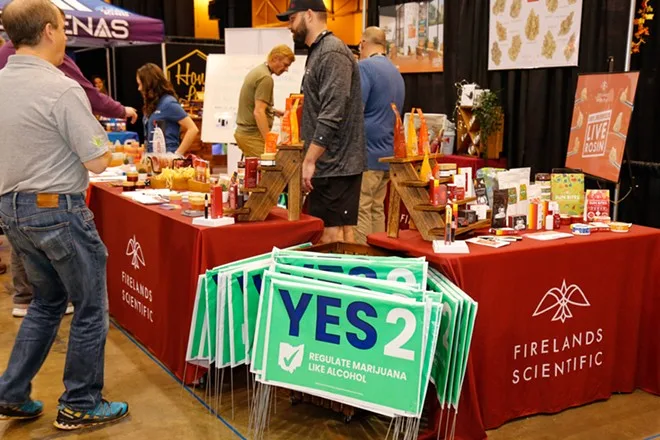Eight years after voters rejected the issue, adult-use marijuana is finally legal in the state as Ohio voters easily voted in favor of Issue 2 on Tuesday. So long as state legislators don’t step in to block voters’ will, Ohio will begin the process of legalization.
The new amendment puts forth plans to address diversity, equity and inclusion in Ohio’s burgeoning legal cannabis industry. Some in the industry doubt the impact the initiatives will have.
“I think that their hearts are in the right place,” said Terrell Washington, director of business operations for Leaf Relief dispensaries. “Do I think that it’s going to be stripped and look very different once the program is up and running? 100 percent. I would bet my life on it. But we do need to do something.”
The history of cannabis in the United States is inextricably linked to racism. Harry Anslinger, appointed the first commissioner of the Treasury Department’s Federal Bureau of Narcotics in 1930, was something of a pioneer in the war on drugs and made no attempt to sterilize his openly racist rhetoric.
“There are 100,000 total marijuana smokers in the U.S., and most are Negroes, Hispanics, Filipinos and entertainers. Their Satanic music, jazz and swing result from marijuana use,” said Anslinger. “This marijuana causes white women to seek sexual relations with Negroes, entertainers and any others.”
The crusade was always something of culture war, entwined with racist campaigns against things like jazz music. Anslinger, who claimed cannabis made users homicidal, went as far as professionally targeting jazz musicians, especially those who were loudly anti-racist, like Billie Holiday.
“It was part of a ploy to overturn the civil rights movements that existed from the ’20s through the ’60s when they were actually successful…there was another war that was created once Blacks were given rights, minorities, Latinos given rights, which was the drug war,” said attorney and secretary of the Minority Cannabis Business Association (MCBA) Brandon Wyatt, who co-created the BCB Mastermind, a free executive training program for cannabis business owners of color, with MCBA chair Todd Hughes.
Today, rhetoric like Anslinger’s is less common and the vast majority of Americans support marijuana legalization. Even John Boehner, who described himself as “unalterably opposed” to legalization efforts when he was in a position to influence them, now has money in the legal cannabis business. Boehner’s even hosted an online seminar and said, “This is the time to go all in on cannabis…cannabis is here to stay and this industry is only getting bigger.”
But despite Boehner’s complete–and profitable–position change, the legacy of the war on drugs remains and many Americans aren’t sharing in the wealth. Although the U.S. accounts for five percent of the global population, it’s home to a quarter of the incarcerated population worldwide.
Today, roughly one in five incarcerated persons in the U.S. is serving time for a drug offense, according to the Drug Policy Alliance. Drug law violations account for more than one million arrests annually in the U.S. in a push that costs taxpayers roughly 47 billion dollars every year.
While cannabis usage rates of Black and White Americans remain similar, according to the Substance Abuse and Mental Health Services Administration, marijuana-related arrest rates are very different. A 2020 report by the American Civil Liberties Union (ACLU) found that Black people in Ohio are 3.4-times more likely than their White counterparts to be arrested on a weed-related offense.
People, families and communities of color have been and continue to be disproportionately targeted by drug law enforcement, and they reap less benefits from the legal cannabis market. According to a 2021 report by Leafly, a site dedicated to information about marijuana, only an estimated two percent of cannabis dispensaries are Black-owned.
This won’t be Ohio’s first round of marijuana legalization, as medicinal use was legalized in 2015. The state medical industry is required to issue at least 15 percent of cultivation, processing or laboratory licenses to, “the following economically disadvantaged groups: Blacks or African Americans, American Indians, Hispanics or Latinos and Asians,” unless it doesn’t receive enough applications.
Despite this stipulation, Washington describes Ohio’s existing medical marijuana market in one word: white.
“My biggest concern is that of non-related [general managers], I don’t know of any Black [general managers] in any dispensary in the state of Ohio who are not related to ownership, which is troubling because that does not reflect consumption or employment of the program as a whole. There’s a lack of equity and inclusion at all levels of the program,” Washington said.
The ACLU report concludes that legalization won’t be enough to address racial injustice without implementing broader reforms and, to its credit, the Ohio law includes provisions to boost diversity, equity and inclusion. So what exactly does Ohio’s law say?
For starters, a 10-percent tax will be levied on adult-use marijuana sales. Of that 10 percent, 36 percent of revenue–which the coalition behind the law estimates will be at least $150 million–will fund a social equity and jobs program.
In order to qualify for the program, applicants must prove both social and economic disadvantages including:
- Wealth-based
- Racial minority
- Personal disadvantage due to color, ethnic origin, gender, physical disability or long-term residence in a high-unemployment area
- Relation to a spouse, child or parent arrested, convicted or adjudicated for a marijuana-related offense before the law goes into effect
- Economic disadvantage based on economic and business size thresholds and eligibility criteria designed to stimulate economic development through license awards to businesses in qualified tracts
For program participants, the law says the program will waive at least fifty percent of license or application fees and provide financial assistance, loans and grants. Industry experts say these kinds of initiatives — monetarily backed — can be transformative.
“Those that come with revenue resources derived from the previous tax dollars that actually help entrepreneurs get operational are the ones that stand out, whether that’s loan or grant programs, and that’s even more imperative because we have a well-known lack of access to small business loans and banking as minorities,” said Wyatt.
People of color are far less likely to be approved for business loans than their white counterparts, which can be prohibitive when starting a business. According to Fed Small Business, a collaboration of 12 reserve banks of the Federal Reserve System, last year 35 percent of white business owners were fully approved for business loans compared to 19 percent of Hispanic, 16 percent of Black and 15 percent of Asian business owners.
40 percent of Black non-applicants did not apply for a loan because they were discouraged by their chances of approval. And the persistence of the federal prohibition of cannabis further complicates things.
“It’s a little bit different when it’s an illegal industry and the bank doesn’t want to give you a loan at all and you don’t have the ability to easily use other businesses or other revenue streams to capitalize your cannabis business,” Wyatt said.
Without funding prospects, predatory lenders can be aspiring business owners’ only option.
Another provision experts say could make a difference is technical assistance, which the social equity and jobs program says it will provide participants.
“Giving access to capital and banking directly would lead to businesses having what was needed to get operational, but also technical assistance, state-based, state-funded technical assistance,” Hughes said. “So accounting, legal, retail real estate support and just understanding all the things that go along with business.”
The program will also establish a process for participants who wish to transfer a license to non-participants without undermining the program and encourage employment of minorities, women, veterans and people with disabilities.
Much of the law’s plan for diversity, equity and inclusion, lacks detail. The program’s funding is essentially the only number laid out in the plans and amounts of financial assistance aren’t described. The law also doesn’t elaborate on how it will do things like provide grants and technical assistance or encourage hiring certain groups. While there’s real potential for Ohio to cultivate a more equitable industry, that future remains uncertain.
“I think that once the bill becomes a law, it’s an extreme uphill battle,” said Washington. “And I think it’s tough to get those who understand that they’re very fortunate to be a part of the industry to stick their neck out.”
Beyond entrepreneurship, the social equity and jobs program lays out plans for community improvement initiatives. To invest in disproportionately impacted communities, it will fund education, youth development, violence prevention, legal aid, entrepreneurship and arts. The program will also study and propose laws to track and prevent underage marijuana use.
For the people currently or formerly incarcerated on cannabis law violations that are now legal in the state, Ohio hasn’t taken steps to implement widespread pardons or resentencing of those serving time, nor does the law include steps to expunge or seal records of marijuana convictions — all of which could be transformative for Ohioans.
However, Ohio’s law does say that the cannabis equity and jobs program will study and fund judicial and criminal justice reform for topics related to marijuana like bail, parole, sentencing, expungement and sealing of records, legal aid and community policing, which could eventually have an effect.
Aside from goals to build an equitable industry that addresses the painful history of marijuana laws in the U.S., the BCB Mastermind creators say a more diverse industry will produce the best products.
“If some of the best minds come together and congeal and share a diversity of thought and then they go out and heal the world…for even the non-believers the tactics are clear that the reason the drug war existed was due to racial minorities and issues in urban neighborhoods,” Wyatt said. “However, if they don’t want to look at clear data and information, I’d urge them to think about the need for diversity of thought in producing the best medications possible.”
Subscribe to Cleveland Scene newsletters.
Follow us: Apple News | Google News | NewsBreak | Reddit | Instagram | Facebook | Twitter | Or sign up for our RSS Feed



